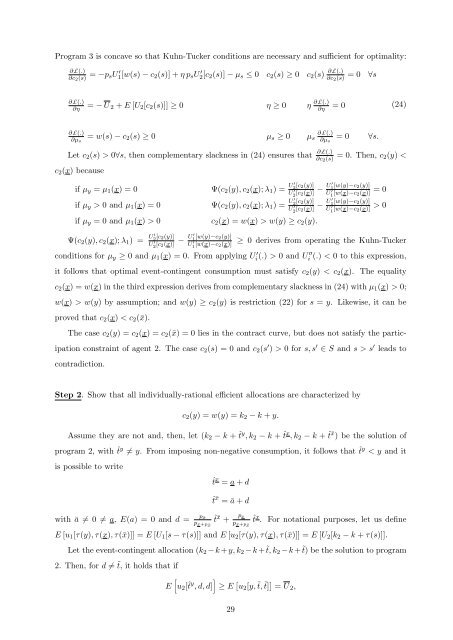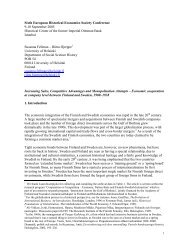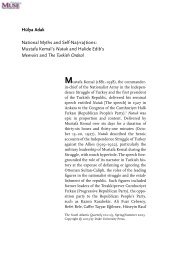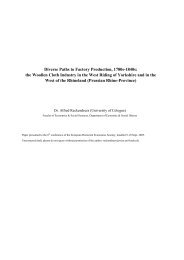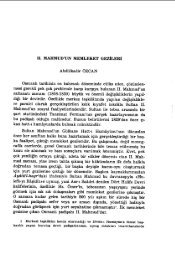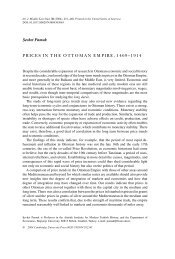The Birth of Insurance Contracts - The Ataturk Institute for Modern ...
The Birth of Insurance Contracts - The Ataturk Institute for Modern ...
The Birth of Insurance Contracts - The Ataturk Institute for Modern ...
Create successful ePaper yourself
Turn your PDF publications into a flip-book with our unique Google optimized e-Paper software.
Program 3 is concave so that Kuhn-Tucker conditions are necessary and sufficient <strong>for</strong> optimality:<br />
∂£(.)<br />
∂c2(s) = −psU ′ 1 [w(s) − c2(s)] + η psU ′ 2 [c2(s)] − µs ≤ 0 c2(s) ≥ 0 c2(s) ∂£(.)<br />
∂c2(s) = 0 ∀s<br />
∂£(.)<br />
∂η = − U 2 + E [U2[c2(s)]] ≥ 0 η ≥ 0 η ∂£(.)<br />
∂η = 0<br />
∂£(.)<br />
∂µs = w(s) − c2(s) ≥ 0 µs ≥ 0 µs ∂£(.)<br />
= 0 ∀s.<br />
∂µs<br />
Let c2(s) > 0∀s, then complementary slackness in (24) ensures that ∂£(.)<br />
∂c2(s) = 0. <strong>The</strong>n, c2(y) <<br />
c2(x) because<br />
if µy = µ1(x) = 0 Ψ(c2(y), c2(x); λ1) = U ′ 2 [c2(y)]<br />
if µy > 0 and µ1(x) = 0 Ψ(c2(y), c2(x); λ1) = U ′ 2 [c2(y)]<br />
if µy = 0 and µ1(x) > 0 c2(x) = w(x) > w(y) ≥ c2(y).<br />
Ψ(c2(y), c2(x); λ1) = U ′ 2 [c2(y)]<br />
U ′ 2 [c2(x)] − U ′ 1 [w(y)−c2(y)]<br />
U ′ 1<br />
conditions <strong>for</strong> µy ≥ 0 and µ1(x) = 0. From applying U ′ i<br />
U ′ 2 [c2(x)] − U ′ 1 [w(y)−c2(y)]<br />
U ′ 1<br />
U ′ 2 [c2(x)] − U ′ 1 [w(y)−c2(y)]<br />
U ′ 1<br />
[w(x)−c2(x)] = 0<br />
[w(x)−c2(x)] > 0<br />
(24)<br />
[w(x)−c2(x)] ≥ 0 derives from operating the Kuhn-Tucker<br />
(.) > 0 and U ′′<br />
i (.) < 0 to this expression,<br />
it follows that optimal event-contingent consumption must satisfy c2(y) < c2(x). <strong>The</strong> equality<br />
c2(x) = w(x) in the third expression derives from complementary slackness in (24) with µ1(x) > 0;<br />
w(x) > w(y) by assumption; and w(y) ≥ c2(y) is restriction (22) <strong>for</strong> s = y. Likewise, it can be<br />
proved that c2(x) < c2(¯x).<br />
<strong>The</strong> case c2(y) = c2(x) = c2(¯x) = 0 lies in the contract curve, but does not satisfy the partic-<br />
ipation constraint <strong>of</strong> agent 2. <strong>The</strong> case c2(s) = 0 and c2(s ′ ) > 0 <strong>for</strong> s, s ′ ∈ S and s > s ′ leads to<br />
contradiction.<br />
Step 2. Show that all individually-rational efficient allocations are characterized by<br />
c2(y) = w(y) = k2 − k + y.<br />
Assume they are not and, then, let (k2 − k + ˆt y , k2 − k + ˆt x , k2 − k + ˆt ¯x ) be the solution <strong>of</strong><br />
program 2, with ˆt y = y. From imposing non-negative consumption, it follows that ˆt y < y and it<br />
is possible to write<br />
ˆt x = a + d<br />
ˆt ¯x = ā + d<br />
with ā = 0 = a, E(a) = 0 and d = p¯x<br />
px+p¯x<br />
ˆt ¯x + px<br />
px+p¯x<br />
ˆt x . For notational purposes, let us define<br />
E [u1[τ(y), τ(x), τ(¯x)]] = E [U1[s − τ(s)]] and E [u2[τ(y), τ(x), τ(¯x)]] = E [U2[k2 − k + τ(s)]].<br />
Let the event-contingent allocation (k2 −k +y, k2 −k + ˜t, k2 −k + ˜t) be the solution to program<br />
2. <strong>The</strong>n, <strong>for</strong> d = ˜t, it holds that if<br />
<br />
E u2[ˆt y <br />
, d, d] ≥ E u2[y, ˜t, ˜t] = U 2,<br />
29


